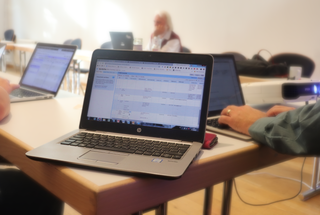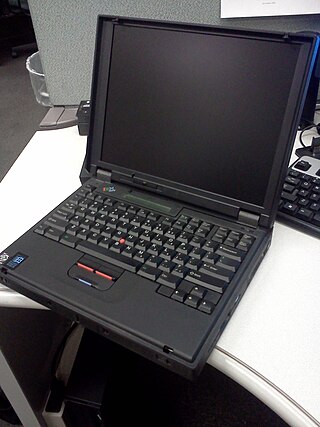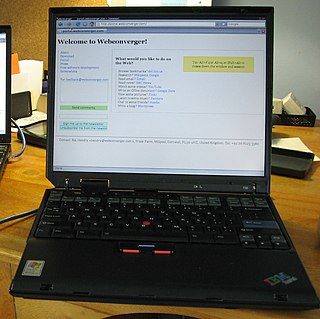
The PowerBook is a family of Macintosh laptop computers designed, manufactured and sold by Apple Computer from 1991 to 2006. It was targeted at the professional market; in 1999, the line was supplemented by the home and education-focused iBook family.

ThinkPad is a line of business-oriented laptop and tablet computers produced since 1992. The early models were designed, developed and marketed by International Business Machines (IBM) until it sold its PC business to Lenovo in 2005; since 2007, all new ThinkPad models have been branded Lenovo instead and the Chinese manufacturer has continued to develop and sell ThinkPads to the present day.

The IBM ThinkPad 701 is a subnotebook in the ThinkPad line by IBM. The 701 is colloquially known as the Butterfly due to its sliding keyboard, which was designed by John Karidis. It was developed from 1993 and sold from March 1995 until later that year and priced between $1,499 and $3,299. The 701 was the most sold laptop in 1995 and has received 27 design awards. It was based on either the DX2 or the DX4 version of the Intel i486, combined with the CT-65545 graphics chip. The 701Cs version used a DSTN display, while the 701C used a TFT LCD. It was pre-installed with Windows 3.11 and for the DX4 models also with OS/2 Warp 3.0. The 701 was discontinued because the keyboard design was no longer a necessity after screen sizes increased. After its discontinuation there has been some speculation about a new notebook with a butterfly style keyboard.

Tadpole Computer was a manufacturer of rugged, military specification, UNIX workstations, thin client laptops and lightweight servers.

The RISC System/6000 (RS/6000) is a family of RISC-based Unix servers, workstations and supercomputers made by IBM in the 1990s. The RS/6000 family replaced the IBM RT PC computer platform in February 1990 and is the first computer line to see the use of IBM's POWER and PowerPC based microprocessors. In October 2000, the RS/6000 brand was retired for POWER-based servers and replaced by the eServer pSeries. Workstations continued under the RS/6000 brand until 2002, when new POWER-based workstations were released under the IntelliStation POWER brand.
The PowerPC 600 family was the first family of PowerPC processors built. They were designed at the Somerset facility in Austin, Texas, jointly funded and staffed by engineers from IBM and Motorola as a part of the AIM alliance. Somerset was opened in 1992 and its goal was to make the first PowerPC processor and then keep designing general purpose PowerPC processors for personal computers. The first incarnation became the PowerPC 601 in 1993, and the second generation soon followed with the PowerPC 603, PowerPC 604 and the 64-bit PowerPC 620.

HP EliteBook is a line of business-oriented laptop computers made by Hewlett-Packard, marketed as a high-end line positioned above the ProBook series. The line was introduced in August 2008 as a replacement of the HP Compaq line of business laptops, and initially included mobile workstations until September 2013, when they were rebranded as HP ZBook. The EliteBook mainly competes against computer lineups such as Acer's TravelMate, Dell's Latitude, Lenovo's ThinkPad and Dynabook's Portégé and Tecra.

IBM ThinkPad 760 was a notebook computer introduced in 1995 by the IBM corporation into the market as part of the ThinkPad 700-series. It was succeeded in 1998 by the ThinkPad 770 series.

IBM ThinkPad 770 was a laptop designed and manufactured by IBM targeted for the business, enterprise and professional user. It was the last lineup in the ThinkPad 700-series, succeeding the 760 as the high-end laptop of the ThinkPad lineup. The line was produced from October 1997 to May 2000, and eventually replaced by the ThinkPad models A20m and A20p.

The ThinkPad E Series is a notebook computer series produced since 2010 by Lenovo. It is the most affordable sibling in the ThinkPad family and is aimed at small business users as well as education markets.

The ThinkPad T series is a line of notebook computers manufactured by Lenovo as part of the ThinkPad family. The T series is officially the flagship ThinkPad product, offering high-performance computers aimed at businesses and professionals. The ThinkPad X series was originally introduced in 2000 and was produced by IBM until 2005.

The ThinkPad X series is a line of notebook computers and convertible tablets produced by Lenovo as part of the ThinkPad family. The ThinkPad X series is traditionally the range best designed for mobile use, with ultraportable sizes and less power compared to the flagship ThinkPad T series. It was initially produced by IBM until 2005.

The IBM ThinkPad T20 series was a series of notebook computers introduced in May 2000 by IBM as the successor of the 770 series and the first model of the T-series which exists today under Lenovo ownership. Four models were produced, the T20, T21, T22, and T23; the series was succeeded in May 2002 by the ThinkPad T30, but was produced until July 2003.

The ThinkPad T60 is a laptop that was manufactured by Lenovo and marketed under the IBM brand.

The ThinkPad T61 is a premium, business-class laptop computer manufactured originally by IBM, which sold the rights to Lenovo. A ThinkPad, it was part of the T series, and was first manufactured in 2006. It was offered as a modular platform, allowing buyers to customize most all of its major features, including processor speed, amount of RAM and hard disk storage, screen size and resolution, quality and speed of video card, and additional capabilities such as a fingerprint reader, smart card reader, and Zip drive. The T61 came with the Windows Vista operating system.

The IBM Thinkpad 350 series was a notebook computer series introduced in 1993 by IBM as part of their Thinkpad laptop series. It was the successor to the IBM ThinkPad 300. With only 2 models ever made in the series, it was succeeded in 1994 by the IBM Thinkpad 360 series.

The IBM ThinkPad 360 series was a notebook computer series introduced in 1994 by IBM as part of their ThinkPad laptop series. It was succeeded in late 1995 by the IBM ThinkPad 365 series.

The IBM ThinkPad 560 is a notebook series from the ThinkPad line by IBM. It has been argued that the ThinkPad 560 was the first ultraportable notebook.

The ThinkPad 755 is a series of high-end notebook-sized laptops released by IBM from 1994 to 1996. All models in the line feature either the i486 processor or the original Pentium processor by Intel, clocked between 50 and 100 MHz. The ThinkPad 755CD, introduced in October 1994, was the first notebook on the market with an internal full-sized CD-ROM drive. The ThinkPad 755 series was the top-selling laptop for much of 1994, beating out competition from Apple Computer and Compaq. IBM replaced it with the ThinkPad 760 series in January 1996.

The IBM ThinkPad T30 is a laptop computer manufactured by IBM.




















